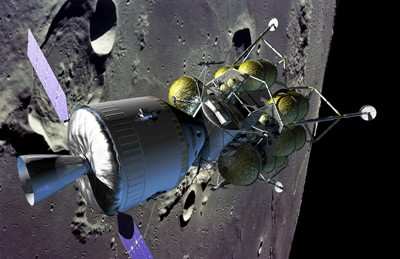Crew Exploration Vehicle Is The Next Ticket To Space Station,
Moon, Mars
A Northrop Grumman-Boeing team Wednesday unveiled its plans to
design and build NASA's proposed Crew Exploration Vehicle (CEV), a
modular space system intended to carry humans to the International
Space Station by 2012 and back to the moon by 2018.

The CEV comprises a crew module that builds on NASA's Apollo
spacecraft, a service module and a launch-abort system. It is
designed to be carried into space aboard a shuttle-derived launch
vehicle -– a rocket based on the solid rocket booster
technology that powers the early phases of current shuttle
flights.
The CEV will be produced both as a crewed space transportation
system and as an uncrewed space vehicle capable of transporting
cargo to and from the International Space Station. NASA expects to
select a CEV prime contractor in the spring of 2006.
According to Doug Young, program manager for the Northrop
Grumman-Boeing CEV team, the team's design approach to the CEV and
the overall mission architecture have been evolving over the past
year.

"We've been working closely with NASA to identify design options
and technologies that would enable the nation to meet its space
exploration goals of safety, affordability and reliability," Young
said. "Early on we concluded that this modular, capsule-based
approach would establish an ideal foundation for a successful,
sustainable human and robotic space exploration program. It's also
a system that can be designed and built today using proven
technologies, which will help maintain the nation's leadership role
in human space flight."
While similar in shape to the Apollo spacecraft that carried
astronauts to the moon in the late '60s and early '70s, the new CEV
is a quantum leap forward in terms of performance, reliability and
on-orbit mission capability.

"The CEV we plan to build will benefit not so much from a
single, technical breakthrough but rather from evolutionary
improvements in structural technologies, electronics, avionics,
thermal-management systems, software and integrated
system-health-management systems over the past 40 years," said
Leonard Nicholson, the Northrop Grumman-Boeing team's deputy
program manager.
According to Nicholson, the CEV offers many fundamental
improvements over Apollo. Among them:
- CEV's crew module will have much more internal volume than the
Apollo capsule, but will only be slightly heavier, due to the use
of advanced structural materials and technologies that reduce the
size, weight and power consumption of key subsystems.
- CEV's crew module will carry up to six astronauts, while Apollo
carried just three.
- CEV will carry more fuel for lunar return than Apollo, allowing
it to change its orbit rather than relying on the moon and the
Earth to be in the right relative positions.

- CEV will be able to operate as an autonomous spacecraft
orbiting the moon for up to six months while its crew of four
descends to the lunar surface in the lunar lander. Crew members and
ground controllers will be able to communicate with the CEV and
monitor its "vital signs" remotely. During the Apollo era, one
astronaut stayed with the "mother ship" while the lunar lander
carrying two astronauts descended to the moon.
- CEV will use two fault-tolerant subsystems and integrated
system-health management systems to allow it to detect, isolate and
recover from subsystem failures. By comparison, Apollo generally
had only single fault tolerance.
 Sierra Space Repositions Dream Chaser for First Mission
Sierra Space Repositions Dream Chaser for First Mission ANN's Daily Aero-Term (05.10.24): Takeoff Roll
ANN's Daily Aero-Term (05.10.24): Takeoff Roll Aero-News: Quote of the Day (05.10.24)
Aero-News: Quote of the Day (05.10.24) Aero-News: Quote of the Day (05.11.24)
Aero-News: Quote of the Day (05.11.24) ANN's Daily Aero-Term (05.11.24): IDENT Feature
ANN's Daily Aero-Term (05.11.24): IDENT Feature






